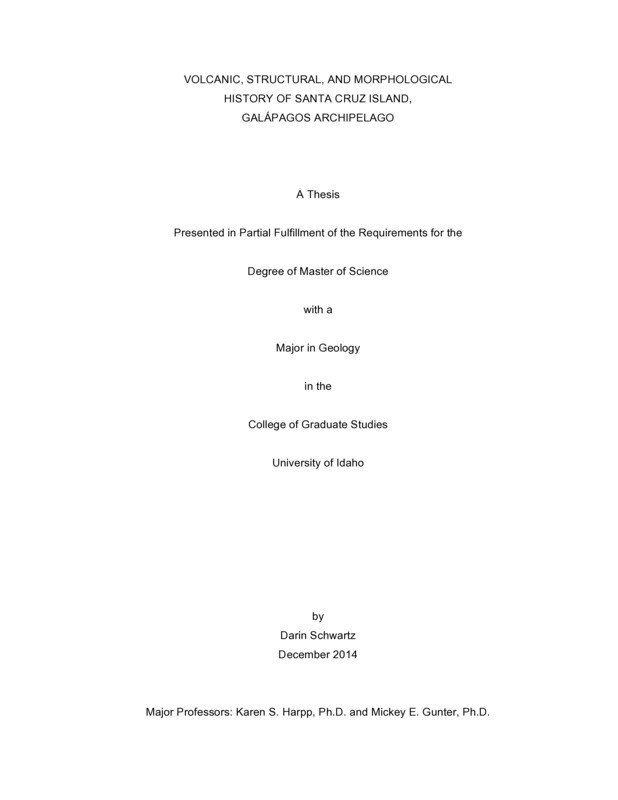VOLCANIC, STRUCTURAL, AND MORPHOLOGICAL HISTORY OF SANTA CRUZ ISLAND, GALÁPAGOS ARCHIPELAGO
Schwartz, Darin. (2014). VOLCANIC, STRUCTURAL, AND MORPHOLOGICAL HISTORY OF SANTA CRUZ ISLAND, GALÁPAGOS ARCHIPELAGO. Theses and Dissertations Collection, University of Idaho Library Digital Collections. https://www.lib.uidaho.edu/digital/etd/items/schwartz_idaho_0089n_10279.html
- Title:
- VOLCANIC, STRUCTURAL, AND MORPHOLOGICAL HISTORY OF SANTA CRUZ ISLAND, GALÁPAGOS ARCHIPELAGO
- Author:
- Schwartz, Darin
- Date:
- 2014
- Keywords:
- galapagos geochronology geology gravity structure volcanology
- Program:
- Geology
- Subject Category:
- Geology; Geochemistry
- Abstract:
-
Santa Cruz Island is one of the oldest volcanoes in the Galápagos Archipelago; little is known about its history or its evolutionary relationship to the younger western shield volcanoes. Of particular note, the island's northern and southern flanks are deformed by a series of major normal faults of unknown origin. Using an array of multidisciplinary tools, including field mapping, global positioning satellite measurements, gravity measurements, 40Ar/39Ar geochronology, and 3He exposure dating, I construct a structural and volcanic history of Santa Cruz. The 40Ar/39Ar ages reveal that since ~1.5 Ma, the island has experienced two phases of volcanism, separated by ~400 ky. The first occurred from 1620 ± 15 to 1160 ± 35 ka (1σ); the second lasted from 699 ± 45 to 74 ± 19 ka. Volcanism during the second phase was focused along an E-W trending summit vent system, from which all lavas erupted <200 ka were deposited on the southern flank. Structural observations suggest that the island has experienced two major faulting episodes. North flank faults formed after 1160 ± 35 ka, whereas the Southern Faults were initiated between 274 ± 18 and 38 ± 8 ka. Gravity results indicate two E-W trending, intrusive complexes; one is centered north of the island's summit and the other is beneath the southern flank. When integrated, our data are consistent with a model wherein the Northern Faults are associated with regional uplift occurring after 780 ka and before 500 ka (Bow, 1979). This deformation event may be related to establishment of the summit vent system and the initiation of the second phase of volcanism. The second volcanism phase is contemporaneous with the formation of the Southern Faults. Southward spreading along the island's southern flank accommodated extension initiated by intrusions, which ceased with volcanism ~30 ka. The extended volcanic activity characteristic of Santa Cruz and of other older Galápagos Islands may be the result of rejuvenated volcanism linked to regional uplift event(s); low volume eruptive fluxes during extended activity downstream of the plume center may explain the morphological differences observed between eastern and western volcanoes in the archipelago.
- Description:
- masters, M.S., Geology -- University of Idaho - College of Graduate Studies, 2014
- Major Professor:
- Harpp, Karen; Gunter, Mickey
- Committee:
- Mittelstaedt, Eric; Phillips, William
- Defense Date:
- 2014
- Identifier:
- Schwartz_idaho_0089N_10279
- Type:
- Text
- Format Original:
- Format:
- application/pdf
- Rights:
- In Copyright - Educational Use Permitted. For more information, please contact University of Idaho Library Special Collections and Archives Department at libspec@uidaho.edu.
- Standardized Rights:
- http://rightsstatements.org/vocab/InC-EDU/1.0/

